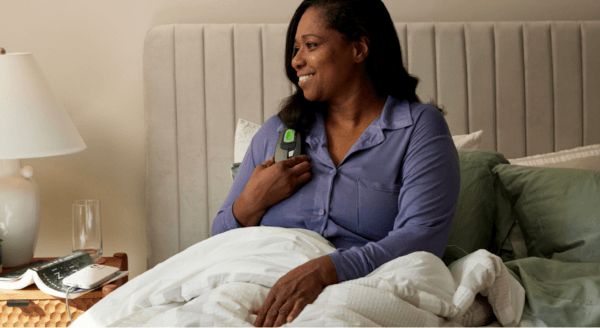

Inspire: A New Treatment for Obstructive Sleep Apnea
by Guest Author
Obstructive sleep apnea (OSA) is more than just a nighttime nuisance—it’s a serious medical condition linked to cardiovascular disease, depression, diabetes, and even dementia. While millions rely on CPAP (Continuous Positive Airway Pressure) machines to manage symptoms, not everyone can tolerate them. Now, a promising alternative called Inspire is changing the landscape of sleep apnea treatment.
We spoke with Omid Mehdizadeh, MD, an otolaryngologist and head and neck surgeon at Pacific Neuroscience Institute, to better understand how this implantable device is helping patients breathe—and sleep—more easily.
What Is Inspire Sleep Apnea Treatment and How Does It Work?
Inspire sleep apnea treatment is a small, pacemaker-like device implanted in the chest wall. It treats obstructive sleep apnea by sending gentle electrical pulses to the throat muscles, keeping the airway open during sleep. While FDA-approved in 2014, the first Inspire implantation at Providence Saint John’s Health Center took place in 2023—performed by Dr. Mehdizadeh himself.
Unlike CPAP, which relies on pressurized airflow through a mask, Inspire works inside the body and is activated at bedtime by the user with a handheld remote. The goal is to offer a less intrusive, more comfortable solution for patients who can’t tolerate CPAP. This innovative airway stimulation system provides a new approach to treat obstructive sleep apnea, especially for those struggling with traditional options like CPAP masks or hoses.
Who Is a Candidate for Inspire Sleep Apnea Treatment?
Inspire is designed specifically for patients with obstructive sleep apnea—not central or mixed apnea, which are caused by brain signaling issues. According to Dr. Mehdizadeh, patients must meet several criteria to qualify for Inspire:
- Failed CPAP therapy
- Apnea-Hypopnea Index (AHI) score under 100
- Body Mass Index (BMI) under 40 (some insurers require under 35)
- Less than 25% central or mixed apnea events
- Drug-induced sleep endoscopy to confirm airway collapse pattern
Because CPAP remains the first-line treatment for OSA, Inspire is only considered after CPAP proves ineffective or intolerable.
What to Expect From the Procedure
The Inspire implantation procedure typically takes 90 minutes to two hours under general anesthesia and is performed on an outpatient basis. Compared to traditional sleep apnea surgeries—many of which involve the throat, tonsils, tongue, or even jaw—Inspire is minimally invasive and doesn’t alter facial structure.
Patients usually return for a post-operative checkup, and the device is activated about six weeks later. Over the next few months, patients gradually increase the stimulation level at home. A follow-up sleep study helps determine whether the device is improving breathing during sleep. “It’s a collaborative process between surgeon and sleep physician,” Dr. Mehdizadeh explains.
How Do You Know If You Have Sleep Apnea?

One of the challenges in treating sleep apnea is that many people don’t realize they have it. “Often, it’s the partner who notices signs like choking or gasping during sleep,” says Dr. Mehdizadeh. Other symptoms may include loud snoring, morning headaches, dry mouth, or daytime fatigue. Diagnosis typically involves a sleep study, often recommended by a primary care doctor or another specialist such as a cardiologist.
Living With the Inspire Sleep Apnea Device: Are There Any Limitations?
After recovery, most patients return to their normal routines without restrictions. The device is MRI-compatible and doesn’t trigger airport metal detectors. Most importantly, it allows many to sleep better without the discomfort of masks, hoses, or external equipment. This minimally invasive stimulation therapy gives patients new hope for managing obstructive sleep apnea, improving quality of life and promoting restful sleep.
Could You Have Sleep Apnea?
Obstructive sleep apnea affects over 3 million Americans each year. Risk factors include:
- Excess weight
- Narrow airways or large tonsils
- Family history of OSA
- Smoking or use of sedatives
- Hormonal changes (e.g., post-menopause in women)
- Certain endocrine conditions like hypothyroidism
Common symptoms include snoring, gasping or choking during sleep, dry mouth, and extreme daytime drowsiness. If you recognize these signs, talk to your doctor about scheduling a sleep evaluation.
Explore Inspire Sleep Apnea Treatment at PNI
If you or a loved one is struggling with obstructive sleep apnea and can’t tolerate CPAP, consider Inspire sleep apnea treatment as an alternative. This minimally invasive option offers a new path to better sleep and improved health.
To learn more about Inspire or to schedule a consultation, contact the experts at Pacific Neuroscience Institute.
About Dr. Omid Mehdizadeh

Omid B. Mehdizadeh, MD, is an otolaryngology-head and neck surgeon specializing in voice, swallowing, and airway conditions at Pacific Neuroscience Institute. A Los Angeles native, Dr. Mehdizadeh’s career spans working with world-renowned performers and serving underserved populations through surgical missions in Central America. He also teaches medical and undergraduate students and provides care through local community clinics.
Obstructive Sleep Apnea Clinic Location
Pacific Neuroscience Institute, 1301 20th St., Santa Monica, CA 90404
Phone: 310-477-5558
Related Links:
Last updated: July 25th, 2025